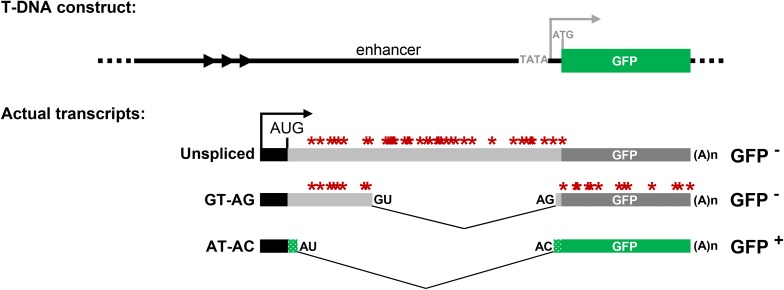Figure 1.
Schematic drawing of T-DNA construct and alternatively spliced GFP reporter gene. Top: The original construct introduced into Arabidopsis contained a GFP reporter gene designed to be under the transcriptional control of a minimal promoter (TATA) and upstream viral enhancer element. However, neither the minimal promoter nor the downstream ATG initiation codon (gray letters) is used in the T line. Bottom: Instead, transcription of GFP pre-mRNA initiates at an upstream promoter region (black bar and arrow) to produce three alternative splicing variants that include the part of enhancer region (Kanno et al. 2008). The actual coding sequence of GFP protein (green bars), which has a unique 27-amino-acid extension (short stippled green bars), is interrupted by intronic sequences (light gray) that comprise a smaller GT-AG intron inserted within a larger U2-type intron with noncanonical AT-AC splice sites (Sasaki et al. 2015; Kanno et al. 2016). Three major GFP splice variants include a long unspliced transcript, a midlength transcript resulting from splicing of the GT-AG intron, and a shorter transcript resulting from splicing of the AT-AC intron. Only the AT-AC transcript lacks premature termination codons (PTCs, red asterisks) and can be translated into GFP protein. Arrowheads represent a short tandem repeat upstream of the promoter. The black AUG represents the main translation initiation codon. The 3′ splice sites for the GT-AG and AT-AC introns are only 3 nt apart with the noncanonical AC on the outside (Sasaki et al. 2015; Kanno et al. 2016, 2017).

